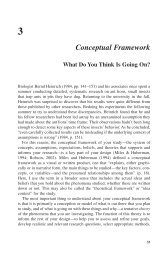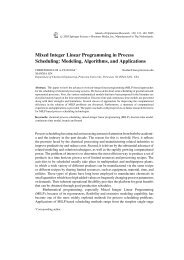Modeling and Calibration of a Structured-light Optical - Michigan ...
Modeling and Calibration of a Structured-light Optical - Michigan ...
Modeling and Calibration of a Structured-light Optical - Michigan ...
Create successful ePaper yourself
Turn your PDF publications into a flip-book with our unique Google optimized e-Paper software.
Given a commercial laser stripe sensor, it is not only unnecessary<br />
but also impossible to perform intrinsic calibration. Therefore<br />
it is impossible to combine the intrinsic <strong>and</strong> extrinsic calibration.<br />
The sensor frame is regarded as stationary instead <strong>of</strong> moving<br />
when skewed frame representation is employed. The advantage<br />
<strong>of</strong> this modeling is that scan data can be pooled as they are<br />
collected, i.e., no postprocessing <strong>of</strong> the data is necessary before<br />
performing extrinsic calibration. This makes it possible to scan<br />
a target in the sensor field <strong>of</strong> view <strong>and</strong> extract desirable feature<br />
points directly from the scanned data for extrinsic calibration.<br />
The use <strong>of</strong> moving frame model prevented Chen <strong>and</strong> Kak<br />
(1987) from knowing where exactly the object points are located<br />
so that they had to scan at least six non-parallel lines on a<br />
polyhedron target for calibration. We present a new tetrahedrontarget-based<br />
extrinsic calibration approach without the use <strong>of</strong><br />
pin-hole assumption. Two scan lines are all that are needed to<br />
calculate the four conjugate pairs, <strong>and</strong> the two lines can be<br />
parallel. The new calibration procedure becomes so simple that<br />
frequent on-line calibration becomes feasible whenever the system<br />
configuration is altered.<br />
5.1 <strong>Calibration</strong> Algorithm Formulation. The same<br />
point Pt in a 3D Euclidean space can be represented by two<br />
sets <strong>of</strong> coordinate vectors, one in the non-Cartesian skewed<br />
sensor frame, Psi = (xsi, ysi, zst) T <strong>and</strong> the other in the Cartesian<br />
world frame, Pwi = (xni,ywi, zwd T • These two coordinate vectors<br />
are <strong>of</strong>ten called "conjugate pairs" because they describe the<br />
same point in two different coordinate systems. For extrinsic<br />
calibration, we need to find the matrix JT from n conjugate<br />
pairs. Then the absolute orientation solution becomes a constrained<br />
least squares optimization problem (Che, 1995). That<br />
is, we want to minimize the augmented objective function<br />
F = I HP* - JT-Psi || 2 + \,[r?, + t 2 2l + t 2 M - 1]<br />
i=l<br />
+ X2-+[f?2 + t\2 + t\2 " 1] + \3[t\3 + th + tj3 - 1]<br />
t22' in + h2' hi ] (21)<br />
where the \,'s are Lagrange multipliers. Since there are four<br />
constraints among the twelve unknowns <strong>of</strong> T, only eight independent<br />
parameters exist. Therefore a minimum <strong>of</strong> three conjugate<br />
pairs are needed as they provide nine coordinates.<br />
However, this makes the algorithm nonlinear. For on-line<br />
use, a linear algorithm has to be found to provide an initial<br />
guess to the nonlinear algorithm. This is achieved by ignoring<br />
the four constraints in Eq. (21). The objective function then<br />
becomes<br />
F = y ii p<br />
*• A^ II * w<br />
sT-Psi<br />
(22)<br />
<strong>and</strong> a minimum <strong>of</strong> four conjugate pairs are needed.<br />
With four pairs <strong>of</strong> calibration points, an initial guess <strong>of</strong> $T<br />
can be determined by<br />
scan lines I <strong>and</strong> n<br />
(a) schematic <strong>of</strong> the target (b) actual target<br />
Fig. 9(a)(6) Tetrahedron target<br />
where<br />
<strong>and</strong><br />
Fig. 10 Scanned image <strong>of</strong> a tetrahedron target<br />
W<br />
S =<br />
P. i<br />
1<br />
w-s~<br />
Pwl Pw3<br />
1 1<br />
Psl Psi<br />
1 1<br />
Pw4<br />
1<br />
PsA<br />
1<br />
(23)<br />
(24)<br />
(25)<br />
If more than four conjugate pairs are used to achieve higher<br />
calibration accuracy, a least squares linear regression will give<br />
the initial guess for fT (Horn, 1986)<br />
where<br />
<strong>and</strong><br />
W =<br />
S =<br />
fT= W-S T -(S-S T y<br />
PS2<br />
1<br />
<strong>and</strong> n is the number <strong>of</strong> conjugate pairs.<br />
(26)<br />
(27)<br />
(28)<br />
5.2 Tetrahedron-target-based <strong>Calibration</strong>. From the<br />
calibration algorithm formulation' we know that at least four<br />
conjugate pairs are needed for a linear initial guess. So the<br />
calibration target should have at least four vertices to be used<br />
as the four conjugate pairs. A theodolite-based calibration approach<br />
was proposed (Dewar, 1988; Greer, 1988; Dewar <strong>and</strong><br />
Greer, 1989). They use a four-wire optical fiber target to create<br />
the conjugate pairs. However, the accuracy <strong>of</strong> the theodolite is<br />
not satisfactory <strong>and</strong> the procedure is time consuming <strong>and</strong> involves<br />
human operator, which makes the automation <strong>of</strong> on-line<br />
calibration impossible. We propose to use a tetrahedron as one<br />
<strong>of</strong> the possible calibration targets.<br />
As can be seen from Fig. 9(a), there are four planes on the<br />
target. Four points A, B, C, <strong>and</strong> D can be uniquely defined as<br />
the intersection points <strong>of</strong> the four planes. The procedure for the<br />
identification <strong>of</strong> the four conjugate pairs is as follows:<br />
(1) Use a mechanical CMM (accuracy should be at least<br />
one order higher than the laser scanner) to sample several<br />
points (at least three) on each face <strong>of</strong> the target.<br />
(2) Apply a least squares plane fitting algorithm to the<br />
600 / Vol. 118, NOVEMBER 1996 Transactions <strong>of</strong> the ASME<br />
Downloaded 26 Sep 2011 to 141.212.97.74. Redistribution subject to ASME license or copyright; see http://www.asme.org/terms/Terms_Use.cfm
















